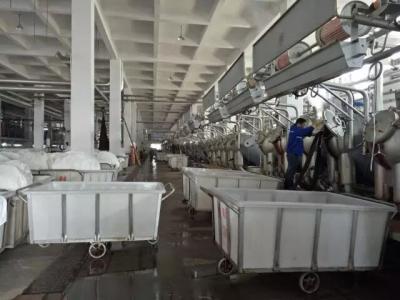Silicon is the second most abundant element in the earth's crust after oxygen which contains about 27.6%, mainly in the form of silicon dioxide and silicate. Through various organic chemical reactions, the hard silicon dioxide has become the most used auxiliary in the textile printing and dyeing industry: silicone softening agent.
1. Brief history of the development of silicone industry
(1) In 1863, French chemists C.Friedel and J.M.Crafts produced the first organic silicon compound SiEt4 containing Si-C bonds.
(2) In the late 1930s, silicone resin was made.
(3) In 1940, simethicone was produced.
(4) In 1943, Dow Chemical and Corning Glass Company jointly established Dow Corning, DC to specialize in the production and research of silicone. In 2016, Dow Chemical acquired the shares held by Corning Glass Company, which has 73 years of ownership and withdrew from the jointly venture.
(5) In 1947, General Electric (GE) established the Silicone Division. In 2006, Apollo acquired the Silicone Business Unit of General Electric for US$3.8 billion and formally established Momentive Performance Materials (MPM). In 2010, Apollo merged MPM and Hexion to form Momentive Performance Materials Holding Co., Ltd. In May 2019, a consortium composed of South Korea KCC, Wonik QnC and SJL Partners L.L.C. formally completed the acquisition of Momentive Group.
(6) In 1947, Dr. Siegfried Nitzsche's report entitled "Silicon-Containing Plastics" persuaded WACKER which in Germany immediately decided to hire this young chemist. Dr. Siegfried Nitzsche later became the father of WACKER silicones. In 1949, Dr. Nitzsche and his colleagues successfully developed the first silane composition. Soon after, the first silane furnace was built and put into use. In 1955, WACKER produced the first silicon rods. In 2005, German Wacker and its Chinese partner Dymatic Investment Co., Ltd. jointly established a company to produce silicone.
(7) In 1952, BAYER began to produce organic silicon, and later a joint venture with GE.
(8) In 1953, Shin-Etsu of Japan began to produce silicone, and in 2002, Zhejiang Shin-Etsu High-Tech Chemical Co., Ltd. was established.
(9) In 1954, France's Rhône-Planck established a new factory in St. Von and created a siloxane and silicon derivative factory (later merged into China's Bluestar Silicones.)
(10) In 1966, Toray of Japan began to produce silicone and later merged into Dow Corning.
(11) In 1968, Xinghuo Chemical Plant was formally established. In 1979, the Ministry of Petrochemical and Jiangxi Provincial Planning Commission approved Xinghuo Plant to build an organic silicon production facility with an annual output of 600 tons. In 1996, Xinghuo Silicone joined China National Bluestar (Group) Co, Ltd.
(12) In 1984, the founder of China National Bluestar (Group) Co, Ltd led 7 people with borrowed 10,000 yuan to establish China's first professional cleaning company. Since 2006, it has successively acquired French Adisseo, French Rhodia's silicone and sulfide business and Australia's Qenos, entered the international market and transformed into a global company. In 2011, it acquired Elkem of Norway. In 2018, Elkem integrated the Bluestar silicon industry chain and listed on the Oslo Stock Exchange in Norway, becoming the first Chinese company to be listed in Norway.
(13) China has become the largest consumer and producer of organic silicon materials.
2. Brief history of the development of silicone softening agent
The first generation is dimethyl silicone oil and hydroxyl modified silicone oil.
Features: low cost, not washable and easy to demulsify. They were once mainly used in spinning oil.
The second generation is epoxy modified silicone softener and amino modified silicone softener.
Features: non-hydrophilic and easy to demulsify. The epoxy modification focuses on dryness while amino modification focuses on smoothness which, however, has yellowing problems.
The third generation is polyether modified silicone softener.
Features: good hydrophilicity, not easy to break the emulsion, but is slightly worse when touching.
The fourth generation is linear block copolymer modified silicone softening agent.
Features: good hydrophilicity, a soft feeling, low yellowing, and not easy to break.



 English
English  日本語
日本語  Español
Español  tiếng việt
tiếng việt  Türkçe
Türkçe  ไทย
ไทย  українська
українська  हिंदी
हिंदी  বাঙালি
বাঙালি  اردو
اردو 

